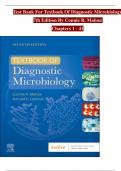Test Bank For Textbook Of Diagnostic Microbiology
7th Edition By Connie R. Mahon
Chapters 1 - 41
, Mahon:DTextbookDofDDiagnosticDMicrobiology,D7thDEditionDTestDBank
TableDofDcontents
PartD1:DIntroductionDtoDClinicalDMicrobiology
ChapterD1.DBacterialDCellDStructure,DPhysiology,DMetabolism,DandDGenetics
ChapterD2.DHost-ParasiteDInteraction
ChapterD3.DTheDLaboratoryDRoleDinDInfectionDControl
ChapterD4.DControlDofDMicroorganisms:DDisinfection,DSterilization,DandDMicrobiologyDSafety
ChapterD5.DPerformanceDImprovementDinDtheDMicrobiologyDLaboratory
ChapterD6.DSpecimenDCollectionDandDProcessing
ChapterD7.DMicroscopicDExaminationDofDMaterialsDfromDInfectedDSites
ChapterD8.D UseDofDColonyDMorphologyDforDtheDPresumptiveDIdentificationDofDMicroorganisms
ChapterD9.D BiochemicalDIdentificationDofDGram-NegativeDBacteria
ChapterD10.DImmunodiagnosisDofDInfectiousDDiseases
ChapterD11.DApplicationsDofDMolecularDDiagnostics
ChapterD12.DAntibacterialDMechanismsDofDActionDandDBacterialDResistanceDMechanisms
ChapterD13.DAntimicrobialDSusceptibilityDTesting
PartD2:DLaboratoryDIdentificationDofDSignificantDIsolates
ChapterD14.DStaphylococci
ChapterD15.DStreptococcus,DEnterococcus,DandDOtherDCatalase-Negative,DGram-PositiveDCocci
ChapterD16.DAerobicDGram-PositiveDBacilli
ChapterD17.DNeisseriaDSpeciesDandDMoraxellaDcatarrhalis
ChapterD18.DHaemophilus,DHACEK,DLegionellaDandDOtherDFastidiousDGram-NegativeDBacilli
ChapterD19.DEnterobacteriaceae
ChapterD20.DVibrio,DAeromonas,DandDCampylobacterDSpecies
ChapterD21.DNonfermentingDandDMiscellaneousDGram-NegativeDBacilli
ChapterD22.DAnaerobesDofDClinicalDImportance
ChapterD23.DTheDSpirochetes
ChapterD24.DChlamydia,DRickettsia,DandDSimilarDOrganisms
ChapterD25.DMycoplasmaDandDUreaplasma
ChapterD26.DMycobacteriumDtuberculosisDandDNontuberculousDMycobacteria
ChapterD27.DMedicallyDSignificantDFungi
ChapterD28.DDiagnosticDParasitology
ChapterD29.DClinicalDVirology
ChapterD30.DAgentsDofDBioterrorDandDForensicDMicrobiology
ChapterD31.DBiofilms:DArchitectsDofDDisease
PartD3:DLaboratoryDDiagnosisDofDInfectiousDDiseases:DandDOrganDSystemDApproachDtoDDiagnosticDMicrobiol
ogy
ChapterD32.DUpperDandDLowerDRespiratoryDTractDInfections
ChapterD33.DSkinDandDSoftDTissueDInfections
ChapterD34.DGastrointestinalDInfectionsDandDFoodDPoisoning
ChapterD35.DInfectionsDofDtheDCentralDNervousDSystem
ChapterD36.DBacteremiaDandDSepsis
ChapterD37.DUrinaryDTractDInfections
ChapterD38.DGenitalDInfectionsDandDSexuallyDTransmittedDInfections
ChapterD39.DInfectionsDinDSpecialDPopulations
ChapterD40.DZoonoticDDiseases
ChapterD41.DOcularDInfections
-
,ChapterD01:DBacterialDCellDStructure,DPhysiology,DMetabolism,DandDGenetic
sDMahon:DTextbookDofDDiagnosticDMicrobiology,D7thDEditionDTestDBank
MULTIPLEDCHOICE
1. ToDsurvive,DmicrobialDinhabitantsDhaveDlearnedDtoDadaptDbyDvaryingDallDofDtheDfollowing,Dexcept
a. growthDrate.
b. growthDinDallDatmosphericDconditions.
c. growthDatDparticularDtemperatures.
d. bacterialDshape.
ANSWER:D D
TheDchapterDbeginsDbyDdiscussingDtheDwayDmicrobialDinhabitantsDhaveDhadDtoDevolveDtoDsurvi
veDinDmanyDdifferentDnichesDandDhabitats.DItDdiscussesDslowDgrowers,DrapidDgrowers,DandDrepli
cationDwithDscarceDorDabundantDnutrients,DunderDdifferentDatmosphericDconditions,Dtemperatur
eDrequirements,DandDcellDstructure.DBacterialDshapeDasDaDformDofDevolutionDisDnotDdiscussed.
OBJ:D LevelD2:DInterpretation
2. WhoDwasDconsideredDtheDfatherDofDprotozoologyDandDbacteriology?
a. AntonDvanDLeeuwenhoek
b. LouisDPasteur
c. CarlDLandsteiner
d. MichaelDDouglas
ANSWER:D A
TheDbookDdiscussesDAntonDvanDLeeuwenhoekDasDtheDinventorDofDtheDmicroscopeDandDtheDfirs
tDpersonDtoDseeDtheD“beasties.”DSoDtheyDdubbedDhimDtheDfatherDofDprotozoologyDandDbacteriolo
gy.DTheDotherDthreeDindividualsDwereDnotDdiscussed.
OBJ:D LevelD1:DRecall
3. ProkaryoticDcellsDhaveDwhichDofDtheDfollowingDstructuresDinDtheirDcytoplasm?
a. GolgiDapparatus
b. Ribosomes
c. Mitochondria
d. EndoplasmicDreticulum
ANSWER:D B
AllDtheDstructuresDlistedDareDfoundDinDeukaryoticDcells,DbutDribosomesDareDtheDonlyDonesDth
atDapplyDtoDprokaryoticDcells.
OBJ:D LevelD1:DRecall
4. ThisDformDofDDNADisDcommonlyDfoundDinDeukaryoticDcells.
a. Linear
b. Circular
c. Plasmid
d. Colloid
.
.
, ANSWER:D A
CircularDandDplasmidDDNADareDusuallyDfoundDonlyDinDbacteria,DnotDeukaryoticDcells.DColloidD
isDaDpropertyDofDproteinDmoleculesDandDisDnotDassociatedDwithDnucleotides.
OBJ:D LevelD1:DRecall
5. TheDnuclearDmembraneDinDprokaryotesDis
a. missing.
b. impenetrable.
c. aDclassicDmembrane.
d. aDlipidDbilayerDmembrane.
ANSWER:D A
ProkaryoticDcellsDdoDnotDhaveDanyDmembrane-
boundDstructuresDinDtheDcytoplasmDincludingDaDstructuredDnucleus.
OBJ:D LevelD1:DRecall
6. ADmicroorganismDthatDisDaDunicellularDorganismDandDlacksDaDnuclearDmembraneDandDtr
ueDnucleusDbelongsDtoDwhichDclassification?
a. Fungi
b. Bacteria
c. Algae
d. Parasite
ANSWER:D B
Fungi,Dalgae,DandDparasitesDareDunicellularDeukaryoticDorganismsDthatDcontainDaDtrueDnucleu
s.DBacteriaDareDprokaryoticDandDdoDnotDcontainDaDtrueDnucleusDorDnuclearDmembrane.
OBJ:D LevelD1:DRecall
7. InDtheDlaboratory,DtheDclinicalDmicrobiologistDisDresponsibleDforDallDtheDfollowing,Dexcept
a. isolatingDmicroorganisms.
b. selectingDtreatmentDforDpatients.
c. identifyingDmicroorganisms.
d. analyzingDbacteriaDthatDcauseDdisease.
ANSWER:D B
ClinicalDmicrobiologistsDdoDnotDselectDtheDtreatmentDforDpatients.DTheyDprovideDtheDdoctorDwi
thDtheDnameDofDtheDorganismDandDtheDantibioticsDthatDcanDkillDtheDbacteria,DbutDnotDinDtheDfinal
DselectionDofDtreatmentDprotocols.
OBJ:D LevelD2:DRecall
8. WhatDenablesDtheDmicrobiologistDtoDselectDtheDcorrectDmediaDforDprimaryDcultureDandDoptimi
zeDtheDchanceDofDisolatingDaDpathogenicDorganism?
a. DeterminingDstainingDcharacteristics
b. UnderstandingDtheDcellDstructureDandDbiochemicalDpathwaysDofDanDorganism
c. UnderstandingDtheDgrowthDrequirementsDofDpotentialDpathogensDatDspecificDbodyDsite
d. KnowingDtheDdifferencesDinDcellDwallsDofDparticularDbacteria
ANSWER:D C




